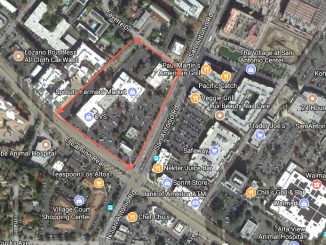
OPINION
BY DAVE PRICE
Daily Post Editor
In Palo Alto, 2018 will be the year of El Camino Real.
City Councilwoman Lydia Kou recently rattled off a list of 11 projects that are in the works for the King’s Highway.
Most of these projects would result in more housing stacked up against the street, 50 feet tall (the city’s height limit). If Palo Alto isn’t careful, El Camino will become a canyon with a street on the bottom and 50-foot walls on either side.
Development in the Bay Area is shifting from office buildings to housing.
Last week, City Council extended its 50,000-square-foot annual limit on office space downtown, in the California Avenue district and along El Camino. Many at the meeting remarked about how the cap hadn’t been reached in either of its first two years.
Older buildings to be replaced
That’s because demand for offices is leveling off and but there’s still a need for more housing. And a state law called a “density bonus” gives developers the ability to build more units on lots near transit than what would otherwise be allowed. Most places along El Camino are eligible for a density bonus.
Businesses that were built in the 1950s are going to be torn down and replaced with 50-foot tall apartment buildings.
An example is the housing development the nonprofit Palo Alto Housing is proposing for 3709 El Camino, where Euromart and three other retailers are located. Palo Alto Housing wants to build 61 apartments for people whose income ranges between $25,000 and $50,000 a year.
Palo Alto Housing hasn’t formally submitted an application for this project to the city, but it asked council on Aug. 28 to provide some feedback before it goes forward.
Problems with density and retail
Two problems surfaced — problems that will probably be repeated with the other projects on El Camino as those developments reach council.
First, Palo Alto Housing’s proposal is too dense for the lot, exceeding city regulations and the Comprehensive Plan. Council would have to change the zoning for that property and change the hallowed Comp Plan, which is a big deal in Palo Alto.
Or, another option officials suggested, is returning to Planned Community, or PC, zoning. Another term for PC zoning is “Let’s Make a Deal,” where a developer gets the right to exceed the city code in exchange for a dubious public benefit, like a piece of modern art or a fountain.
The second problem is that this housing building boom might frustrate the city’s desire to preserve retail on the ground floor of commercial buildings. Candace Gonzalez, head of Palo Alto Housing, said the various grants and tax-exempt bonds they intend to use to finance this project won’t allow part of it to be retail.
Redefining ‘retail’
So council began an odd discussion about what kind of retail they might allow in the 2,000-square-feet of street-facing space of this proposed building. Maybe a nonprofit could inhabit the space? Or perhaps it could be a community meeting room?
But when people think of retail, they think of stores where they can buy things, a restaurant, or maybe a bank or a gym. It was funny to hear council members throwing out ideas about what kind of retail they could allow since they have never shown that kind of flexibility before when interpreting the ground-floor retail ordinance for other property owners in the city.
However, making retail succeed is more than just allocating a portion of a building as retail. Council can’t just wave a magic wand and declare that a store will be successful in a given location.
If retail is to succeed, stores will need signs people can see on El Camino. Shoppers will also want to see that there’s parking they can use (I can’t believe the city painted a red curb in front of the new College Terrace Market — what were they thinking!).
And the rents have to be affordable for mom and pops.
Right now, many of the older businesses on El Camino pay low rents or own their own property. When those stores are replaced with a new housing development, the rent for the required ground floor retail area will probably be sky high — much higher than a mom-and-pop could afford. Who will pay that kind of rent? Chain stores — probably not what council wants.



